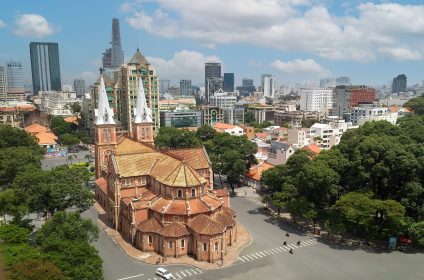
How To Travel To Hoi An
Get In - By Plane
The nearest airport, which is Da Nang (DAD), provides links to Hanoi, Ho Chi Minh City, Nha Trang, Can Tho and Da Lat internally as well as to Singapore, Siem Reap (Angkor Wat), Seoul, Tokyo, Hong Kong. In addition, there are flights from Bangkok or Chiang Mai and charter flights to China.
From the airport in Da Nang to Hoi An a taxi with a meter would cost you around $22. On this occasion it would be cheaper to bargain for an agreed amount than use a meter. To get to the airport take air – conditioned minibus taxis that cost $5 per person (there are no minibuses from the airport; firstly you should go down town). It will take roughly 45 minutes.
Get In - By Train
Hoi An lacks railway station. The station nearest to Hoi An is Da Nang (+84 511 3750666) and has a number of trains from Hanoi, Ho Chi Minh City, Hue, Nha Trang, etc every day. Many travel agencies, hotels and online retailers have train tickets for sale.
Get In - By bus
From Da Nang
From the bus station in Da Nang to the bus station in Hoi An, there is a public bus number 1. From around 05:30 to 17:50, the bus operates approximately every 20 minutes, and the journey takes just under an hour. See the DanangBus website for the 18,000 ong fare. Although many of Vietnam’s bus ticket collectors and conductors are trustworthy, this route is typically devoid of them, and Westerners will be duped if they have the opportunity.
Don’t be duped; know the exact fare. The official fare is shown on signs above the driver and to the left of the front entrance door. Even if the collector offers you to enter through the back door, try to enter through the front door and examine the prices (take a photo or use the above posted photo to drive the point home). If your suitcase truly occupies an entire seat, the collector may try to convince you that baggage is additional. However, this is not the case. The collector can show you a 50,000-ong bill that was handed to them by an elderly woman on the bus; this is a scam, and the women later receive a large sum of money back to mislead tourists. When you hand over a larger bill than you thought you would receive in change, you will be charged 30,000 or 50,000 dong per person instead, and the collector will act as though they don’t understand when you complain. The collector’s claims should be disregarded, and each passenger should give him 18,000 hong (or 20,000 hong if you don’t have smaller change and are ready to suffer the loss) in exact change. He will criticize you and want more. Continue holding out the money while ignoring him. He will return and collect it once some time has passed.
The bus travels in circles across downtown Da Nang and the northern part of the city. Visit https://www.danangbus.vn/roadmap.html to view the route, and visit http://ecobus.danang.gov.vn/web/guest/homepublish to view real-time bus positions. Your lodging in Da Nang ought to be able to direct you to the closest station if you’re staying there.
When exiting the railway station, cross the plaza, go along Hoàng Hoa Thám road, and turn left at the next junction with Lê Dun to find the bus stop closest to the station, which is in front of 155 Lê Dun road (GPS 16.0704, 108.2147). The bus stop at 355 Lê Dun Road still advertises the 01 bus as stopping there as of January 2018, however it no longer does. You can reach the correct one at 155 Lê Dun road by continuing to walk for another 500 meters. The closest bus station from the Da Nang airport appears to be close to the Museum of Cham Sculpture (270 Trn Ph; GPS 16.0620, 108.2232; approximately a 35-minute walk or a 3-kilometer taxi ride).
The bus arrives in Hoi An at the bus terminal at 67 Nguyn Tt Thành, Hoi An.
This is roughly 15 minutes’ walk, or 1.5 kilometers, northwest of the ancient town center (though the first couple of minutes are not very pretty). From there, buses for the return trip also depart. From the Hoi An bus terminal to the old town, a xe om should cost between 15,000 and 30,000 dong.
The Da Nang train station is 700 meters away from the #01 bus as it travels back. Stops at 166 Lê Dun and 79 Ng Ch Khiêm are the closest.
The distance from the hotel to the airport in Danang is 120,000 dong (1 hour).
Other destinations
Private buses and travel agencies abound, offering service to and from Hoi An to places including Hue, Hanoi, Saigon, Dalat, and Nha Trang. For an additional fee, guesthouses can organize tickets, although they might not give you access to them until after you leave.
Anyone coming by bus without an open ticket should be informed that they can instead be let off at a guesthouse approximately a 10-minute walk from the bus station rather than at the Hoi An bus station. You can get to your accomodation for USD 1-2 using the motorbike taxis or tuk-tuks that are waiting for your bus there.
Open-tour buses travel the coast daily from Da Nang to Hue (312–4 hours, 90,000–100,000 dong), Nha Trang, and other destinations (9–10 hr).
If requested, buses from Buon Ma Thuot or other central Highlands cities bound for Da Nang will drop you off at Hoi An at a halt along the highway. To get anywhere in town from there, a 15-minute motorcycle ride is required.
Get In - By taxi
Taxi fare from Da Nang is 500,000 dong (2022); en route, there is a shop selling stone handicrafts. You should be prepared to pay at least 1,200,000 ong if you’re traveling from Hue.
Get In - By boat
The original Champa method of transport involved using the river system. The hundreds of kilometers of rivers in Hoi An provide an intriguing and exciting alternative to traveling by road. Once you board a boat, you’ll start to see much more of Hoi An and the delta. Boats can be rented for roughly $1/hour.















